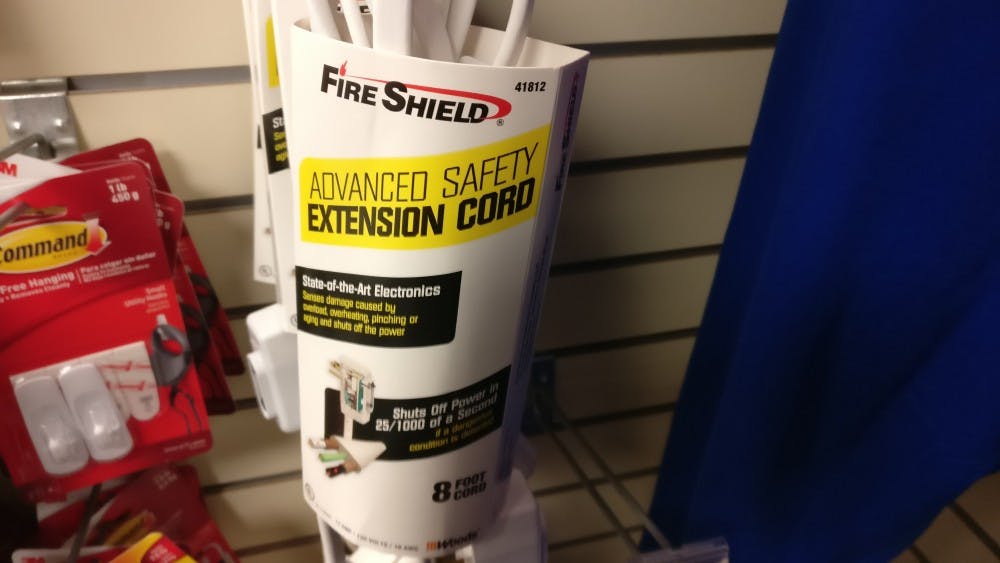In a corner of the University of Richmond bookstore, among aisles of Spider attire, hang Fire Shield power strips and extension cords. These cords are costly yet required purchases for students who want to use electrical products in campus housing.
In the UR bookstore, the 6-outlet 3-foot-long power strip currently costs $32.99, and the 3-outlet 8-foot-long extension cord costs $21.99.
Both prices are notably higher than similar non-Fire Shield products.
Instead of using pre-purchased products they brought to college on move-in day, many students are forced to pay the higher costs to follow university policy. Those refusing to do so are given Category B fire safety violations and fined if caught by fire safety inspections conducted by area coordinators.
Student violations are recorded cumulatively, so past violators do not get annual resets, Patrick Benner, director of residence life and undergraduate student housing, said. Benner's department handles the enforcement of UR’s fire safety policy.
As a result, many students reluctantly buy Fire Shield products, wondering just how Fire Shield provides the “Advanced Safety” it claims on its product labels.
“It’s absurd, plain and simple,” David Brakman, senior, said.
Fire Shield products were selected for UR in 2004 because the company’s products provided additional cord protection that other products lacked, fire safety specialist Michael Bowles, the man in charge of updating UR’s Housing Fire Safety Policy, said.
Bowles said cords can be damaged through pinching under furniture or overheating under rugs, which could lead to short circuiting and fires. He said Fire Shield technology detects cord damage and responds to prevent these dangers.
“There is an extra wire, they call it a drain, that runs through the entire cord portion," he said. “If there is any cramping in there, it changes the resistance that the controls are looking for and it just cuts off."
Addressing student concerns with pricing, Bowles said Fire Shield’s extra layer of protection justified the high price.
He said a cord caught on fire during move-in day in 2001, his first year at UR, but “there have been none of those instances since we went to the Fire Shield."
Enjoy what you're reading?
Signup for our newsletter
“I would still say, even though the product is expensive, that it is worth the extra protection that we get from electrical cord fires," he said.
Bowles said Environmental Health and Safety, his department at UR, initially looked for products similar to Fire Shield’s because of cord fire concerns. He said 50 percent of electrical fires were cord-related.
But, according to a 2017 report from the National Fire Prevention Association, electrical fires involving cords accounted for just 10 percent of fires involving electrical distribution, lighting and power transfer, and 6 percent of total home structure fires.
Captain Earl Dyer, the acting fire marshal for the City of Richmond, said cords weren't the problem. Electrical fires involving cords were rare in his experience. Faulty outlets account for many more, he said.
He added that he believed standard fused and UL-approved surge protectors were sufficient. But he acknowledged that private institutions such as UR could insist on more, to further protect property and student lives.
Brakman echoed Dyer’s sentiment that UR's Fire Shield policy was unnecessary.
“It seems like a regular extension cord is sufficient as long you don’t do anything that would ordinarily be problematic in your own house,” Brakman said.
An observational investigation by The Collegian in Jepson Hall, Ryland Hall and Gottwald Center for the Sciences found that UR’s academic and administrative buildings do not use Fire Shield products.
Bowles said UR’s housing fire safety policy did not pertain to other buildings.
When asked why, he mulled over an explanation because he said he had not been working here when the policy was first written. He said he guessed it was because students lived in residence halls, which categorized the buildings as R-2 Residential Occupancies and came with distinct fire code requirements.
“The risk involved in an academic building, as compared to the residential occupancy, is much smaller because we don't have students living there overnight, sleeping,” Bowles said. “A lot of these cord fires, or fires in general, happen when people are asleep."
Bowles said smoke inhalation was the most common cause of death in a fire, which would prove more dangerous if students were sleeping, as opposed to in academic buildings.
“People will be awake,” Bowles said. “They would notice the fire start and respond quickly enough."
Although Valerie Szalanczy, sophomore, said she understood and accepted the reasoning behind requiring Fire Shield products, she said she didn't think Bowles’ guess was valid. She said students sleep in other buildings as well.
“I’ve slept in the library before, I’ve slept in Jepson before,” Szalanczy said. “I mean, if you’re doing work and you’re there till 4 a.m., sometimes it’s just not worth it to walk all the way back to Lora Robins. I would believe that every building should be treated the same since we live in these residence halls, but essentially we’re all over campus.”
Currently, almost all residence halls require that Fire Shield products are used. The newer buildings, Westhampton Hall and the Gateway Village Apartments, are exceptions because they have built-in preventative measures in their outlets that account for cord damage.
A search for better options was done in 2014 with no success, Bowles said.
Contact news writer Arrman Kyaw at arrman.kyaw@richmond.edu.
Support independent student media
You can make a tax-deductible donation by clicking the button below, which takes you to our secure PayPal account. The page is set up to receive contributions in whatever amount you designate. We look forward to using the money we raise to further our mission of providing honest and accurate information to students, faculty, staff, alumni and others in the general public.
Donate Now


